INSTRUCTION MANUAL
GUIDE D'UTILISATION
MANUAL DE INSTRUCCIONES
INSTRUCTIVO DE OPERACIÓN, CENTROS DE SERVICIO Y PÓLIZA
DE GARANTÍA. ADVERTENCIA: LÉASE ESTE INSTRUCTIVO
ANTES DE USAR EL PRODUCTO.
DEWALT Industrial Tool Co., 701 East Joppa Road, Baltimore, MD 21286 (AUG04-CD-1)
Form No. 626352-00 DW217, DW221, DW222, DW223, DW223G, DW223-220,
DW226, DW231, DW235G, DW235-220, DW236, DW238, DW239, DW245,
DW246, DW248, DW249 Copyright © 2002, 2004 D
EWALT
The following are trademarks for one or more DEWALT power tools: the yellow and black color
scheme; the “D” shaped air intake grill; the array of pyramids on the handgrip; the kit box configura-
tion; and the array of lozenge-shaped humps on the surface of the tool.
Questions? See us in the World Wide Web at www.dewalt.com
DW217/DW221/DW222/DW223/DW223G/DW223-220/DW226/DW231/DW235G
DW235-220/DW236/DW238/DW239/DW245/DW246/DW248/DW249
Drills
Perceuses
Taladros
General Safety Rules
WARNING! Read and understand all instructions. Failure to follow all instruc-
tions listed below may result in electric shock, fire and/or serious personal injury.
SAVE THESE INSTRUCTIONS
WORK AREA
• Keep your work area clean and well lit. Cluttered benches and dark areas invite accidents.
• Do not operate power tools in explosive atmospheres, such as in the presence of flam-
mable liquids, gases, or dust. Power tools create sparks which may ignite the dust or fumes.
• Keep bystanders, children, and visitors away while operating a power tool. Distractions
can cause you to lose control.
ELECTRICAL SAFETY
• Grounded tools must be plugged into an outlet properly installed and grounded in
accordance with all codes and ordinances. Never remove the grounding prong or
modify the plug in any way. Do not use any adaptor plugs. Check with a qualified elec-
trician if you are in doubt as to whether the outlet is properly grounded. If the tools
should electrically malfunction or break down, grounding provides a low resistance path to
carry electricity away from the user. The DW223G and the DW235G units are grounded.
Applicable only to Class I (grounded) tools.
• Double insulated tools are equipped with a polarized plug (one blade is wider than the
other.) This plug will fit in a polarized outlet only one way. If the plug does not fit fully
in the outlet, reverse the plug. If it still does not fit, contact a qualified electrician to
install a polarized outlet. Do not change the plug in any way. Double insulation elim-
inates the need for the three wire grounded power cord and grounded power supply system.
Applicable only to Class II (double insulated) tools. The DW217, DW221, DW222, DW223,
DW226, DW231, DW235, DW236, DW245 and DW246 units have a polarized plug. The
DW217, DW221, DW222, DW223, DW223-220, DW226, DW231, DW235, DW235-220,
DW236, DW238, DW239, DW245, DW246, DW248 and DW249 units are double insulated.
The DW223-220, and DW235-220 units are rated at 230 volts and they are fitted with the
220 volt style plug which is not polarized.
• Avoid body contact with grounded surfaces such as pipes, radiators, ranges and
refrigerators. There is an increased risk of electric shock if your body is grounded.
• Don’t expose power tools to rain or wet conditions. Water entering a power tool will
increase the risk of electric shock.
• Do not abuse the cord. Never use the cord to carry the tools or pull the plug from an out-
let. Keep cord away from heat, oil, sharp edges or moving parts. Replace damaged cords
immediately. Damaged cords increase the risk of electric shock.
• When operating a power tool outside, use an outdoor extension cord marked “W-A”
or “W.” These cords are rated for outdoor use and reduce the risk of electric shock. When
using an extension cord, be sure to use one heavy enough to carry the current your product
will draw. An undersized cord will cause a drop in line voltage resulting in loss of power and
overheating. The following table shows the correct size to use depending on cord length and
nameplate ampere rating. If in doubt, use the next heavier gage. The smaller the gage num-
ber, the heavier the cord.
Minimum Gage for Cord Sets
Volts Total Length of Cord in Feet
120V 0-25 26-50 51-100 101-150
240V 0-50 51-100 101-200 201-300
Ampere Rating
More Not more AWG
Than Than
0-6 18161614
6 - 10 18 16 14 12
PERSONAL SAFETY
• Stay alert, watch what you are doing and use common sense when operating a power
tool. Do not use tool while tired or under the influence of drugs, alcohol, or medication.
A moment of inattention while operating power tools may result in serious personal injury.
• Dress properly. Do not wear loose clothing or jewelry. Contain long hair. Keep your
hair, clothing, and gloves away from moving parts. Loose clothing, jewelry, or long
hair can be caught in moving parts. Air vents often cover moving parts and should also
be avoided.
• Avoid accidental starting. Be sure switch is off before plugging in. Carrying tools with
your finger on the switch or plugging in tools that have the switch on invites accidents.
• Remove adjusting keys or switches before turning the tool on. A wrench or key that is
left attached to a rotating part of the tool may result in personal injury.
• Do not overreach. Keep proper footing and balance at all times. Proper footing and
balance enables better control of the tool in unexpected situations.
• Use safety equipment. Always wear eye protection. Dust mask, non-skid safety shoes,
hard hat, or hearing protection must be used for appropriate conditions.
TOOL USE AND CARE
• Use clamps or other practical way to secure and support the workpiece to a stable
platform. Holding the work by hand or against your body is unstable and may lead to loss
of control.
• Do not force tool. Use the correct tool for your application. The correct tool will do the
job better and safer at the rate for which it is designed.
• Do not use tool if switch does not turn it on or off. Any tool that cannot be controlled
with the switch is dangerous and must be repaired.
• Disconnect the plug from the power source before making any adjustments, chang-
ing accessories, or storing the tool. Such preventative safety measures reduce the risk
of starting the tool accidentally.
• Store idle tools out of reach of children and other untrained persons. Tools are dan-
gerous in the hands of untrained users.
• Maintain tools with care. Keep cutting tools sharp and clean. Properly maintained
tools, with sharp cutting edges are less likely to bind and are easier to control.
• Check for misalignment or binding of moving parts, breakage of parts, and any other
condition that may affect the tools operation. If damaged, have the tool serviced
before using. Many accidents are caused by poorly maintained tools.
• Use only accessories that are recommended by the manufacturer for your model.
Accessories that may be suitable for one tool, may become hazardous when used on
another tool.
SERVICE
• Tool service must be performed only by qualified repair personnel. Service or
maintenance performed by unqualified personnel could result in a risk of injury.
• When servicing a tool, use only identical replacement parts. Follow instructions in
the Maintenance section of this manual. Use of unauthorized parts or failure to follow
Maintenance Instructions may create a risk of electric shock or injury.
Additional Safety Rules
• Hold tool by insulated gripping surfaces when performing an operation where the
cutting tools may contact hidden wiring or its own cord. Contact with a “live” wire will
make exposed metal parts of the tool “live” and shock the operator.
• Keep handles dry, clean, free from oil and grease. It is recommended to use rubber
gloves. This will enable better control
• DO NOT TOUCH ANY METAL PARTS OF THE TOOL when drilling or driving into
walls, floors or wherever live electrical wires may be encountered. Hold the tool only
by insulated grasping surfaces to prevent electric shock if you drill or drive into a live wire.
CAUTION: Wear appropriate hearing protection during use. Under some conditions and
duration of use, noise from this product may contribute to hearing loss.
WARNING: Some dust created by power sanding, sawing, grinding, drilling, and other con-
struction activities contains chemicals known to cause cancer, birth defects or other repro-
ductive harm. Some examples of these chemicals are:
• lead from lead-based paints,
• crystalline silica from bricks and cement and other masonry products, and
• arsenic and chromium from chemically-treated lumber (CCA).
Your risk from these exposures varies, depending on how often you do this type of work. To
reduce your exposure to these chemicals: work in a well ventilated area, and work with
approved safety equipment, such as those dust masks that are specially designed to filter out
microscopic particles.
• Avoid prolonged contact with dust from power sanding, sawing, grinding, drilling,
and other construction activities. Wear protective clothing and wash exposed areas
with soap and water. Allowing dust to get into your mouth, eyes, or lay on the skin may
promote absorption of harmful chemicals.
WARNING: Use of this tool can generate and/or disburse dust, which may cause serious
and permanent respiratory or other injury. Always use NIOSH/OSHA approved respiratory pro-
tection appropriate for the dust exposure. Direct particles away from face and body.
•
The label on your tool may include the following symbols. The symbols and their definitions
are as follows:
V..........volts A ..........amperes
Hz........hertz W ........watts
min ......minutes ........alternating current
....direct current
n
o ........no load speed
........Class II Construction …/min ..revolutions per minute
........earthing terminals ........safety alert symbol
Anti-Lock Control (DW239, DW249)
Your DEWALT drill may come with an electronic feature called Anti-Lock Control. It is designed
to help you control the drill during a stall and keep it from pulling out of your hands. This may
be encountered when drilling in steel or using large bits in wood.
As a stall situation presents itself, the motor cycles on and off for a set period of time. This
takes up the reaction of the stall and allows you to keep the drill under control. The speed con-
trol senses your release of the trigger and resets the motor to run again.
Figure 4 shows the instruction label mounted behind it. There are three alert signals.
1. Check Level: One flash each time the trigger is depressed. Everything is functioning sat-
isfactorily. If there is no flash, the tool should be returned to a D
EWALT authorized service
center for repair.
2. Engaged Level: Should a stall condition still exist, the electronics will shut down the tool
and the light will be steady on. When the unit is running in normal mode, there will be no
light.
3. Alert Mode: A series of continual flashes as the trigger is pulled indicates that the elec-
tronics are no longer functioning. The tool may still be able to function without the benefit
of AntiLock Control but should be serviced as soon as possible.
Motor Brushes
DEWALT uses an advanced brush system which automatically stops the drill when the brush-
es wear out. This prevents serious damage to the motor.
Switch
To start drill, depress trigger switch; to stop the drill, release trigger. To lock trigger in the on
position for continuous operation, depress trigger and push up locking button “A” shown in fig-
ure 1, then gently release the trigger. To release the locking mechanism, depress the trigger
fully, then release it. Before using the tool each time, be sure that the locking button release
mechanism is working freely.
Do not lock the switch on when drilling by hand so that you can instantly release the trigger
switch if the bit binds in the hole.
The locking button is for use only when the drill is mounted in a drill press stand or otherwise
held stationary.
Be sure to release the locking button before disconnecting the plug from the power supply.
Failure to do so will cause the tool to start immediately the next time it is plugged in. Damage
or injury could result.
THE VARIABLE SPEED TRIGGER SWITCH
This switch permits speed control: the farther the trigger is depressed, the higher the speed of
the drill.

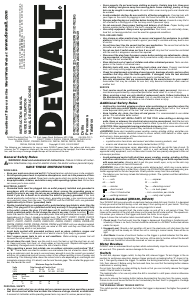


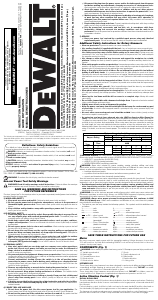
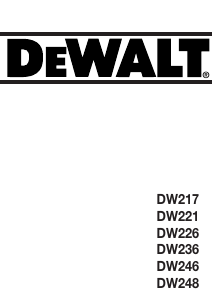
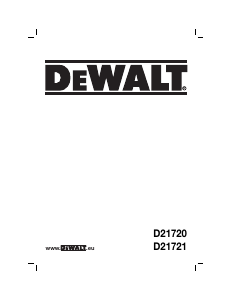


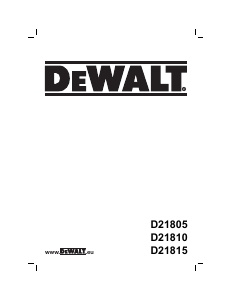

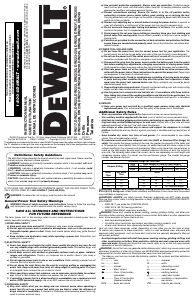
Join the conversation about this product
Here you can share what you think about the DeWalt DWD210G Impact Drill. If you have a question, first carefully read the manual. Requesting a manual can be done by using our contact form.